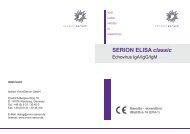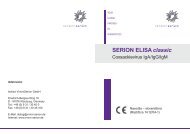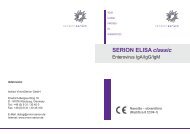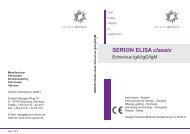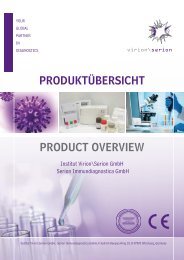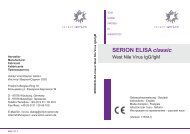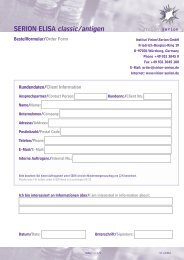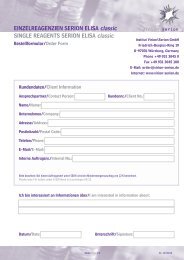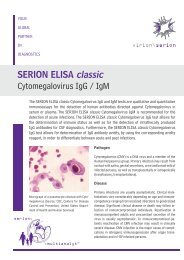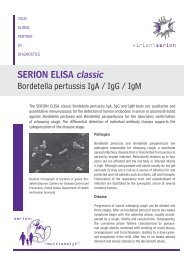Create successful ePaper yourself
Turn your PDF publications into a flip-book with our unique Google optimized e-Paper software.
Pos: 45 /Ar bei tsanl eitungen ELISA cl assic/Gültig für all e D okumente/ELISA classic/T estauswertung/Kapi tel überschrift: Refer enzbereiche gesunder Pr obanden @ 8\mod_1258644290978_18.doc @ 26750 @ 28.6 Interpretation of ResultsENPos: 44 /Ar bei tsanl eitungen ELISA cl assic/Gültig für nur ein D okument/Testauswertung/<strong>Influenza</strong>/<strong>Influenza</strong>: Interpr etation der Ergebnisse @ 11\mod_1329739684374_18.doc @ 50435 @Antibody response following infection with the <strong>Influenza</strong> Virus depends on the individualimmune status, the medical history and the circulating virus subtypes. Following aninfection, antibodies of all three subclases can be found. In addition to IgG and IgAimmunglobulins, IgM antibodies can also be detected in 60 % of primary infections.However in cases of subsequent infection, IgM antibodies play a minor role. Only in 30 %of all non-primary infections are IgM antibodies are found. New subtypes of <strong>Influenza</strong>Viruses can appear as a consequence of antigenic shift and these can trigger an immuneresponse indicative of primary infection even after several previous infections with other<strong>Influenza</strong> Virus subtypes. Within the first two weeks post onset of symptoms, theconcentrations of IgA and IgM immunglobulins reach their maximum levels, whereas IgGantibodies peak after four to six weeks. Following acute infection, IgG immunglobulins aredetectable for more than a year while IgM antibodies are present for up to four months andIgA antibodies may persist for up to a year.To improve the reliability of influenza diagnostics, titer dynamics should be taken intoaccount: initial serum after onset of disease, follow-up serum after two or three weeks.Single sera should always be examined in the different Ig classes. In case of questionableresults, the analysis of follow–up sera is recommended.EL ENCS PTIn general, the evaluation of vaccination titers is not possible with SERION ELISA classic<strong>Influenza</strong> A or <strong>Influenza</strong> B Virus tests, since the used antigen consists primarily of nucleoandmatrix proteins. In contrast, most vaccines consist of membrane proteins in order toelicit neutralizing antibodies. However, new developed vaccines may also contain matrixproteins. In that case antibody titers may be detectable with the SERION ELISA classic<strong>Influenza</strong> A or <strong>Influenza</strong> B Virus after immunization.Due to the range of possible clinical symptoms, other viral and bacterial agents such asRSV, Adenoviruses, Coxsackievirus, Parainfluenza Virus, Coxiella burnetii andMycoplasma pneumoniae should be taken into account for a differential diagnosis.8.7 Reference Range of healthy IndividualsPos: 46 /Ar bei tsanl eitungen ELISA cl assic/Gültig für nur ein D okument/Testauswertung/<strong>Influenza</strong>/<strong>Influenza</strong>: Refer enzbereich g esunder Probanden @ 11\mod_1329739700645_18.doc @ 50452 @The examination of serum samples from randomly selected blood donors from southernGermany using SERION ELISA classic <strong>Influenza</strong> A Virus IgA and IgG tests resulted in thefollowing distribution: 39 out of 43 serum samples (90.7 %) were classified as negativewith the SERION ELISA classic <strong>Influenza</strong> A Virus IgA test, three samples (7.0 %) showeda positive test result and one serum sample (2.3 %) was classified as borderline. 40 out of43 serum samples of unselected blood donors (93.0 %) were negative when tested withthe SERION ELISA classic <strong>Influenza</strong> A Virus IgG assay, two samples (4.7 %) showed apositive test result and one serum (2.3 %) was evaluated as borderline. Similarly, theSERION ELISA classic <strong>Influenza</strong> B Virus IgA and IgG tests gave following results: 41 outof 43 (95.3 %) were negative for both immunoglobulin classes (IgG + IgA). In each caseone serum (2.3 %) yielded a positive or borderline test result.The examination of serum samples of randomly selected blood donors from southernGermany using SERION ELISA classic <strong>Influenza</strong> A Virus IgM test resulted in the followingenglish 19




